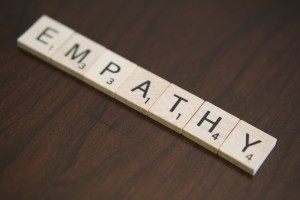This post is also available in Dutch.
As Christmas holidays approach, we become kinder and more generous. We try to find time for our friends and family, and we open our hearts more often to those who are less fortunate. It seems that we empathize more, but what is happening in the brain when we empathize, and why do we empathize more easily in one situation than another?
 Picture by Sharon Sinclair (CC BY 2.0 licence).
Picture by Sharon Sinclair (CC BY 2.0 licence).
When you empathize with another person, you do not experience the exact same feeling. However, your brain mimics, in some way, what that person is feeling: for example, pain. The anterior cingulate cortex and the anterior insula are part of a bigger brain network known as the ‘pain matrix.’ These brain areas are active when we experience pain and when we see another person in a painful situation. The same goes for other sensations such as disgust; the same brain areas are active when we watch a person experiencing disgust as when we experience it ourselves.
Cognitive overload
A recent study showed that empathizing might be easier for those who are less distracted and able to focus on another person’s problem. Participants looked at pictures of people in sad situations. In one part of the experiment, they were asked to imagine how the people in the pictures feel. In the other, they were asked to look at the pictures while memorizing an eight-digit number at the same time. This attentionally demanding situation decreased the neural empathic responses of people with naturally lower empathy. However, people with higher empathy were still able to empathize, even when they faced this distraction. This means that highly empathic people empathize more automatically.
How real is your pain?
How realistic a situation appears can also impact empathy. In one study, people looked at pictures of body parts in painful situations and at cartoons of those pictures. Stronger activation of the pain matrix was observed in response to the pictures than to the cartoons.
Can I feel sorry for you if I don’t understand your sorrow?
A recent study investigated how people respond to the pain of others in a situation that they personally would not find painful. Participants looked at pictures of hands being touched by soft objects. They were told that the people in the pictures suffered from a rare condition: namely, the touch of soft objects was painful to them. Participants were asked to imagine the pain the people with the rare condition would experience. As a result, activation of the pain matrix was observed. This result suggests that we are able to empathize with people who feel pain in situations that we would find painless.
As you can see, different factors can impact our capability to empathize. Overall, it seems that paying attention to other people’s problems, taking a moment to imagine what they feel and acknowledging that their problems are real might be helpful in empathizing with them, even if we ourselves would react differently in the same situation.
More information:
Empathy and pain
Empathy and cognitive overload
Empathy and dissimilar others
This blog was written by Kasia
Edited by Romy
